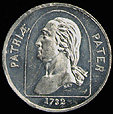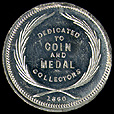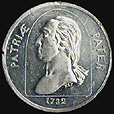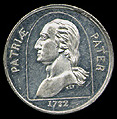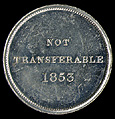Muled Washington Medals and Tokens ca.1860 - Continued
Below is the continuation of a group of unusual muled medals and tokens using the obverse Washington die produced by the diemaker F.C. Key of Philadelphia. The New York City diemaker George Hampden Lovett used this die, along with a variety of his own dies, to produced limited runs of several combinations; most were produced in quantities of twenty items or less. It is generally though these mules were made at the request of the New York City tobacco merchant and token dealer Joseph N.T. Levick. Only those mules containing the Washington portrait and held by Notre Dame are treated here. For further details see: Rulau and Fuld, pp. 149 and 259; Rulau, Standard Catalog of United States Tokens, 2nd ed., pp. 179 and 245-247
obverse |
|
reverse |
| |||
Baker 634A Coin and Medal Collectors 1860 [G.H. Lovett] [New York City]
Obverse: PATRIÆ PATER [in exergue] 1732. [KEY under truncated shoulder]
Reverse: DEDICATED / TO / COIN / AND / MEDAL / COLLECTORS / [below crossed palm branches] 1860
White metal Weight: 114.3 g (7.40 grams) Diameter: 27.9 mm Reverse die alignment: 360°
Comments: The obverse was struck using the F.C. Key die depicting an undraped bust left of Washington within an arched frame. Note there is a die crack that travels from the bottom rim at about 7:00 o'clock up through Washington's throat, jawbone and hair to the rim at about 1:00 o'clock. The reverse depicts the legend within a wreath of two crossed palm branches with the date below. The token was produced in silver and white metal, the silver having a rarity of nine, with a population of two to four examples and the white metal having a rarity of 7 with a population of between ten and nineteen examples. This is one of only two dated example in the Lovett series of mules using Key's die as is the basis for dating the series to ca. 1860.
This reverse was also joined with the witch obverse by George Lovett (Miller NY 491A-491C). The witch obverse carries Lovett's initials and was issued as a medal rather than as a storecard, so the link to Lovett is his initials as the diemaker. The use of this reverse in the muled Washington series is possibly contemporary with the witch medal, as the witch die was also used in the Washington series 9see the next entry). From this dated example it seems the Washington mules could date to 1860 or possible sometime soon after.
Provenance: Part of an anonymous donation consisting of 1100 tokens and medals covering the Nineteenth century, primarily up through the Civil War era.
References: Rulau and Fuld, p. 259; Rulau, Standard Catalog of United States Tokens, 2nd ed., p. 246 for the Lovett witch medal.
obverse |
|
reverse |
| |||
Baker 635B We All Have Our Hobbies [ca. 1860] [G.H. Lovett] [New York City]
Obverse: PATRIÆ PATER [in exergue] 1732. [KEY under truncated shoulder]
Reverse: WE ALL HAVE OUR HOBBIES [below are the initials GHL]
White metal Weight: 111.4 g (7.22 grams) Diameter: 27.9 mm Reverse die alignment: 360°
Comments: The obverse was struck using the F.C. Key die depicting an undraped bust left of Washington within an arched frame. Note there is a die crack that travels from the bottom rim at about 7:00 o'clock up through Washington's throat, jawbone and hair to the rim at about 1:00 o'clock. Additionally the die seems to have buckled inward on both sides, more prominently from 11:00 o'clock to about 4:00. The reverse depicts a witch riding a broomstick and carrying a crutch in her right hand. below are the initials GHL for the diemaker George Hampden Lovett. The token was produced in copper, brass and white metal, the copper having a rarity of nine, with a population of two to four examples and the white metal having a rarity of 8 with a population of between five and nine examples, while the other metals have a rarity of 7 with between ten and nineteen examples.
This witch reverse was also used as an obverse and joined with the 1860 Coin and Medal Collectors reverse (Miller NY 491A-491C). For additional information see the entry above.
Provenance: Part of an anonymous donation consisting of 1100 tokens and medals covering the Nineteenth century, primarily up through the Civil War era.
References: Rulau and Fuld, p. 259; Rulau, Standard Catalog of United States Tokens, 2nd ed., p. 246 for the Lovett witch medal.
obverse |
|
reverse |
| |||
Baker 636B Non Transferable 1853 [ca. 1860] [G.H. Lovett] [New York City]
Obverse: PATRIÆ PATER [in exergue] 1732. [KEY under truncated shoulder]
Reverse: NON / TRANSFERABLE / 1853
White metal Weight: 114.6 g (7.43 grams) Diameter: 28.1 mm Reverse die alignment: 350°
Comments: The obverse was struck using the F.C. Key die depicting an undraped bust left of Washington within an arched frame. Note there is a die crack that travels from the bottom rim at about 7:00 o'clock up through Washington's throat, jawbone and hair to the rim at about 1:00 o'clock. The reverse was the original reverse for the 1853 Mobile, Alabama Jockey Club medal (Miller Ala 2-5). See Baker 337A above for the obverse of the Mobile Jockey Club medal. The token was produced in copper, brass and white metal, with only four examples each in copper and brass and fifteen in white metal.
Provenance: Part of an anonymous donation consisting of 1100 tokens and medals covering the Nineteenth century, primarily up through the Civil War era.
References: Rulau and Fuld, p. 259; Rulau, Standard Catalog of United States Tokens, 2nd ed., p. 246 for the Lovett witch medal.
| Muled1 | Section Contents | 1860-69a |
